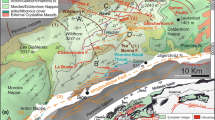Abstract
The Conolly diagram is a section or plan on which the distances from the vein to an arbitrary reference plane are contoured. This graphical technique makes it possible to depict the shape of the vein in a form which resembles topographic contour maps. The Conolly diagram can be used to analyse the relation between oreshoot development in fault-related veins, the attitude of the irregular fault plane and slip direction of the fault.
A new graphical discrimination method has been developed by which an apparent-slip direction “b” is determined in the Conolly diagram by comparing the variations in attitude of the vein with the variations in thickness of the corresponding fissure opening. Theoretically, ore shoots in dextral faults are located where the acute angle “α” between the apparent-slip direction “b” and the fault surface is smaller than zero and in sinistral faults where “α” is greater than zero. This method of interpretation is especially useful when analysing obliqueslip fault systems, which are difficult to study because of the complexities of the three-dimensional problem.
Similar content being viewed by others
References
Anderson, A.F.: The Boise basin, Idaho. In: Newhouse, W.H. (ed.): Ore deposits as related to structural features: Princeton University Press, p. 132–134 (1942)
Australian Mining: Central Norseman gold: p. 86–89 (February 1974)
Badgley, P.C.: Structural methods for the exploration geologist: New York, Harper, 280 p. (1959)
Bell, A.D.M.: Vein contouring technique: 8th Commonwealth Mining and Metallurgical Congress Australia and New Zealand, Melbourne, Publ. Vol. 2, 280–282 (1965)
Conolly, H.J.C.: A contour method of revealing some ore structures. Econ. Geol. 31:259–271 (1936)
von Cotta, B.: Die Lehre von den Erzlagerstätten. Erster Teil: Freiberg, Buchhandlung J.G. Engelhardt, 161 p. (1859)
Emmons, W.H.: Certain ore shoots on warped fault planes: Trans. Am. Inst. Mining Metall. Petroleum Engineers 178:58–81 (1948)
Garnett, R.H.T.: Relationship between tin content and structure of lodes at Geevor Mine, Cornwall: Trans. Instn. Mining Metall., Sect. B, 75:1–22 (1966)
Gough, D.: Structural analysis of ore shoots at Greenside Lead Mine, Cumberland, England: Econ. Geol. 60:1459–1477 (1965)
Hulin, C.D.: Structural control of ore deposition: Econ. Geol. 24:15–49 (1929)
Koch, G.S., Jr. and Link, R.F.: Statistical analysis of geological data. V. 2: New York, John Wiley, 438 p. (1971)
Landis, G.P. and Rye, O.R.: Geologic, fluid inclusion, and stable isotope studies of the Pasto Bueno tungsten-base metal ore deposit, northern Peru. Econ. Geol. 69:1025–1059 (1974)
Lovering, T.S. and Goddard, E.N.: Geology and ore deposits of the Front Range Colorado: U.S. Geol. Surv. Prof. Pap. 223 (1950)
McKinstry, H.E.: Structural control of ore deposition in fissure veins: Trans. Am. Inst. Mining Metall. Petroleum Engineers. 144:65–95 (1941)
McKinstry, H.E.: Norseman Mine, Western Australia. In: Newhouse, W.H. (ed.) Ore deposits as related to structural features: Princeton University Press, p. 224 (1942)
Newhouse, W.H.: Openings due to movement along a curved or irregular fault plane. Econ. Geol. 35:445–464 (1940)
O'Driscoll, D. Operations on the Norseman field. In: Edwards, A.B. (ed.): Geology of Australian ore deposits, 5th Empire Mining and Metallurgical Congress Australia and New Zealand. 1:138–149 (1953)
Ragan, D.M. Structural geology — an introduction to geometrical techniques, 2nd ed.: New York, John Wiley, 208 p. (1973)
Spurr, J.E.: The Camp Bird compound veindike. Econ. Geol. 20:115–152 (1925)
Taylor, R.G.: Distribution and deposition of cassiterite at South Crofty mine, Cornwall: Trans. Instn. Mining Metall., Sect. B. 75:35–49 (1966)
Taylor, R.G.: Geology of tin deposits: Amsterdam, Elsevier, 543 p. (1979)
Wisser, E.: The Pachuca Silver District, Mexico. In: Newhouse, W.H. (ed.): Ore deposits as related to structural features: Princeton University Press, p. 229–235 (1942)
Author information
Authors and Affiliations
Rights and permissions
About this article
Cite this article
Schwartz, M.O. Interpretation of the Conolly contour diagram of fault-related veins. Mineral. Deposita 21, 1–11 (1986). https://doi.org/10.1007/BF00204355
Received:
Accepted:
Issue Date:
DOI: https://doi.org/10.1007/BF00204355




